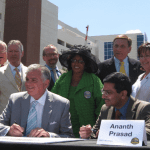Monday’s more than 90 degree heat didn’t stop about 400 Central Floridians, elected officials and government representatives from turning out to witness the historic kick off of phase one of SunRail, the region’s first-ever commuter rail system, at one of the station stops–Florida Hospital.

Estimated to generate over 13,000 new jobs and bring economic benefits to the region of over $1.5 billion, U.S. Transportation Secretary Ray LaHood, said that SunRail “is a great day of celebration” for all of Central Florida.
“Central Florida got its act together and look at what is happening–SunRail is coming,” LaHood said.
LaHood lauded the many persons who had worked diligently on the rail project over many years, in particular paying tribute to Congressman John Mica (R-FL), Congresswoman Corrine Brown (D-FL) and Orlando’s Mayor Buddy Dyer. In particular, LaHood pointed out that the project was a bi-partisan one and not even Florida’s rejection of High Speed Rail could prevent SunRail from moving forward.
“This is the definition of that vision thing,” LaHood declared. “You are celebrating the vision thing today.”
Congressman John Mica noted that, the significance of today was not only the beginning of Transit Oriented Development (TOD) in Central Florida, but the thousands of jobs that would be associated with SunRail. It is estimated that TOD connected with SunRail will generate over 245,000 new jobs and over $7 billion in economic benefits.
“We are going to build it…. The best is yet to come.” Mica declared.
Mayor Dyer, for his part, underscored the collaboration and public-private partnership that had been fostered in bringing SunRail to fruition and even when the project was subjected to negative media. He paid tribute to the several counties and the elected officials that stood behind the rail line–Volusia, Seminole, Orange, Osceola and the City of Orlando.
“Collaboration and partnership have been key to making SunRail a reality,” said Dyer. “Because governments stood together, even when we hit a few road blocks–we stood unified.”
Dyer pointed out that Florida Hospital was just one of 17 station stops.
The 61-mile commuter rail line will make 16 other stops at: Debary Station, Sanford Station, Lake Mary, Longwood, Altamonte Springs, Maitland, Winter Park, Lynx Station, Church Street, Orlando Health Station, Sand Lake, Deland, Meadow Woods, Osceola Parkway, Kissimmee and Poinciana Station.
Congresswoman Brown also praised the partnership that had been built around SunRail and declared that there couldn’t have been a better partner than Congressman Mica, Mayor Dyer and CSX, from whom SunRail has purchased tracks.
Some $432 million has been expended to purchase the Central Florida Commuter Rail Corridor from CSX, the entire sum to be reinvested back into Florida’s rail network including access to ports.
Alluding to the Gov. Rick Scott’s rejection of High Speed Rail earlier this year, Brown said that “one day we will have High Speed Rail.”
“We will move our state forward and I am just so excited for the people of Central Florida,” Brown declared.
Capital costs for phases I & II total $615 million, with the Full Funding Grant Agreement for phase I amounting to $357.2 million. The funding agreement provides 50 percent federal funding for capital costs for Phase I of the SunRail project. The state will pay 25 percent and local governments – Volusia, Seminole, Orange, and Osceola counties and the City of Orlando – will pay the other 25 percent of the capital costs.


